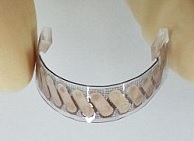Giving wearable tech a whole new angle, this could allow a person to charge his or her own gadgets.
Recent technology news from Korea may seem quite futuristic, but that seems to be the case on an increasing basis when it comes to mobile devices and the many shapes, forms, functions, and styles in which they are being developed.
As though smartwatches and augmented reality glasses weren’t enough, now chargers could be powered by humans.
This technology news could mean that the day could one day arrive in which a person may be able to charge his or her smartphone or wearable technology device through the heat that is naturally produced by his or her body. This is an important discovery, as one of the main barriers to the evolution of the basic smartwatches and other wearables that we know today, is the fact that their charge simply doesn’t last long enough to allow them to provide a wide range of powerful features or function consistently for a long time between charges.
This technology news involves a new development in thermoelectric generating tech.
Should this solution, which is based on a thermoelectric generator made out of glass fabric, become successful, it could pave the way for a virtually endless range of small smart devices and gadgets.
 The discovery has been made by a research team at KAIST University, which is located in South Korea. Under electrical engineering Professor Cho, the team has proposed a unique new solution to being able to keep wearable technology powered through the use of a glass fabric based thermoelectric generator. That device functions by collecting body heat and converting it into usable energy that can charge small mobile devices. It takes advantage of the temperature difference between the human skin and the outside air, so that it can be converted into electric energy.
The discovery has been made by a research team at KAIST University, which is located in South Korea. Under electrical engineering Professor Cho, the team has proposed a unique new solution to being able to keep wearable technology powered through the use of a glass fabric based thermoelectric generator. That device functions by collecting body heat and converting it into usable energy that can charge small mobile devices. It takes advantage of the temperature difference between the human skin and the outside air, so that it can be converted into electric energy.
In order to be able to power a small device, only a small temperature difference between the skin and air is required. This is an important part of this technology news as it ensures that even a slight difference in temperature will allow the charger to continue working, meaning that it won’t be dependent on a perfect air temperature to function at all.
The results of a new data analysis are now suggesting that smartwatches and other wearable tech may be great for employees.
According to the results of a study that was recently commissioned by Rackspace, the adoption of wearables within a workplace can be beneficial to the productivity of a company’s workers and can even help to boost job satisfaction.
As wearable technology becomes increasingly popular, this insight could help to boost its adoption.
The research showed that while wearables can have several benefits, there have also been concerns raised by professionals in IT departments, regarding the security of these newly released devices. They have cautioned that newly generated data could not only have a lower mobile security level than on laptops, smartphones, or tablets, but it could also cause an explosion in the workload for those IT departments as a range of new wearable technology devices – and all of their associated problems and questions – flood a workplace.
The findings of this wearables study are the result of the Human Cloud at Work project.
 The Human Cloud at Work project examines the difference that mobile devices such as smartwatches and fitness trackers can make to a corporate working environment. According to the project’s leader, Chris Brauer, “Wearable technologies are arguably the biggest trend since tablet computing, so it’s natural that employees and businesses will look to use these devices in the workplace.”
The Human Cloud at Work project examines the difference that mobile devices such as smartwatches and fitness trackers can make to a corporate working environment. According to the project’s leader, Chris Brauer, “Wearable technologies are arguably the biggest trend since tablet computing, so it’s natural that employees and businesses will look to use these devices in the workplace.”
Brauer also went on to explain that “Using data generated from the devices, organizations can learn how human behaviors impact productivity, performance, well-being and job satisfaction.” The study indicated that nearly one in three large British businesses are already planning or practicing a trial or pilot program for wearable tech.
Though that figure may seem large, the American figure is even larger than that, as nearly two out of every three large businesses in the U.S. said that they were planning to or were currently testing the use of this type of gadget.
Clearly the predictions that 2014 would be the year of the wearables are proving to be quite true, as companies and consumers, alike, show their interest in this type of technology.
 The discovery has been made by a research team at KAIST University, which is located in South Korea. Under electrical engineering Professor Cho, the team has proposed a unique new solution to being able to keep wearable technology powered through the use of a glass fabric based thermoelectric generator. That device functions by collecting body heat and converting it into usable energy that can charge small mobile devices. It takes advantage of the temperature difference between the human skin and the outside air, so that it can be converted into electric energy.
The discovery has been made by a research team at KAIST University, which is located in South Korea. Under electrical engineering Professor Cho, the team has proposed a unique new solution to being able to keep wearable technology powered through the use of a glass fabric based thermoelectric generator. That device functions by collecting body heat and converting it into usable energy that can charge small mobile devices. It takes advantage of the temperature difference between the human skin and the outside air, so that it can be converted into electric energy.
 The Human Cloud at Work project examines the difference that mobile devices such as
The Human Cloud at Work project examines the difference that mobile devices such as 